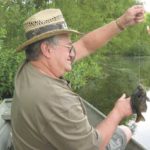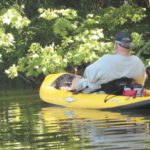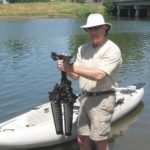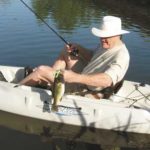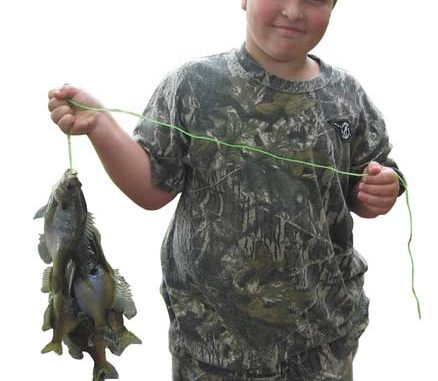
These innovative boats will put you on the fish, and they’ll leave you smiling at the filling station.
I can remember when a quarter’s worth of gasoline would putt-putt you around the lake all day long. Today, you can’t motor away from the dock on a quarter’s worth of gas.
I was reading a newspaper story recently that revealed how times have changed for the fisherman. A boater enjoying a day on the Red River in his party barge put pencil to pad and determined that his fuel tab for his round-trip fun excursion set him back $360.In the same story, a houseboater reportedly filled his tanks for a day on the water, and his tab at the pump was a staggering $600.
Unless you possess a bottomless bank account, there is little doubt the privilege of having fun on the water today is going to keep most sportsmen back on the bank. As a result of exorbitant prices at the pump, many anglers are pursuing alternatives that enable them to still enjoy the sport of fishing without having to mortgage the farm. Some of these alternatives take us back to the very basics of why we became fishermen anyhow.
When I was a kid growing up within walking distance of creeks and ponds, fuel costs were the farthest things from our young minds. We enjoyed hours on the shore, and often came home with more fish than some anglers do today after a hard day fishing from a boat powered by a gas-guzzling engine.
Recently, I visited my childhood home, and met up with my brother and two cousins for a reunion of sorts. At the end of a couple hours of fishing from the banks and paddle boats burning not one single drop of gasoline, we cleaned all the fish we needed for a delicious fish fry.
I keep a small boat on the shore of a private pond near home, and when I get ready to go fishing, I mount my trolling motor on the boat, hook it to the deep-cycle battery I keep fully charged, and I’m in business.
There are other modes of plying fishing waters that you can enjoy without spending a dime for fuel once you reach the water. South Louisiana anglers slide easily along dark bayous and marshes in pirogues, and they catch plenty of fish from these slender boats. Others use canoes with similar results. The only fuel you’ll need is for your body after a day fighting the water with a boat paddle.
I discovered a method of covering fishing waters recently that still has me wagging my head in disbelief. The boat I sat in has no motor to suck down expensive gasoline, does not need a troll motor to move it along the water and incredibly, does not even require a paddle. I fished from a Hobie Cat kayak and the only regret I had was when the trip ended and I had to plant my feet back on terra firma.
My host for the kayak excursion on the Cane River near Natchitoches was Jackie Smith who, like me, is a graduate of Northwestern State. This, however, is where our similarities cease. I ended up as an outdoor writer, while Smith became someone sports scribes wrote about.
Smith, 68, graduated from Northwestern in 1963, where he starred as a record-setting tight end for the Demons. Even at 6-4 and weighing 235 pounds, Smith’s speed is what caught the eyes of professional scouts; he had been clocked in the 100-yard dash in 9.8 seconds and at 4.6 seconds in the 40.
The St. Louis Cardinals drafted Smith, and his contract by today’s standards was laughable. As we walked down a side street in Natchitoches after our Cane River excursion, he stopped and pointed out a spot that triggered a memory.
“I was headed to the bank with my signing bonus in one hand; my contract in the other, and I stopped right about here, and I remember wondering how in the world they could afford to pay me this much to play football. My signing bonus check was for $1,000; my contract was for $11,000,” Smith recalled, chuckling.
After a 15-year career as a tight end for the Cardinals, Smith compiled a bevy of records. At the time of his retirement, his 7,918 receiving yards were the most ever by a tight end. During his playing career, Smith played in five consecutive Pro Bowls, and was named All-NFL two seasons. After retiring from the National Football League in 1978, he was inducted into the NFL Hall of Fame in 1994.
With football in his rearview mirror, Smith, who still lives in St. Louis, became friends with a guy who introduced him to a new kind of fishing boat, the kayak. He was immediately interested because he grew up fishing the ponds and rivers around his hometown of Kentwood.
“Being able to get out and have fun on the water started with me as a kid,” he said. “I still remember going to the banks of the Tangipahoa River with my buddies, Charlie and Jimmy, to spend time with an old guy — we called him Uncle Boots — who taught us a lot about the outdoors.
“We’d sometimes camp out there for two to three days at a time, sleeping on the ground with our boat upside down over us as a shelter. Uncle Boots showed us how to catch, clean, cook and eat turtles and how to shoot a gun. Those are some memories that have stayed with me throughout the years.”
His lifelong interest in the outdoors was rekindled after a life of football when his friend loaned him a kayak to fish ponds and backwaters around St. Louis.
“My friend eventually bought the Hobie Cat company, and I was so impressed with this little boat and what it can do that I have worked with him for the past 10 years or so showing outdoor writers the capabilities of the Hobie boats,” Smith said.
The pirogue is a small narrow boat; the canoe is a small narrow boat; the Hobie Cat kayak is a small narrow boat, but beyond these basic similarities, the Hobie leaves all other competitors paddling frantically in its wake. The reason for this is that while those sitting in pirogues and canoes are furiously paddling, the guy in the Hobie Cat is leisurely pedaling. This is all due to the marvelous propulsion system, the Mirage Drive, that the Hobie Cat kayak utilizes.
Smith invited me to the Cane River to test the boats for myself; his college roommate Wayne Earp joined us. I admit a degree of apprehension after I agreed to the test. I’m no spring chicken, and the thought of sitting in a skinny splinter of a boat I pedaled like a bicycle conjured up all sorts of frightful images. If I shifted my chew of Red Man from one cheek to the other, would the boat tip over? What if my legs couldn’t hold out to work the pedals? What if I embarrassed myself by having to wave the white flag of surrender in front of this former professional athlete who knows a wimp when he sees one?
It took about 10 seconds after getting in the boat to allay all my fears. The kayak pedaled like a dream; I liken it to slowly pedaling a well-oiled, finely tuned bicycle along a smooth and level path.
Stability? Not a problem. Earp, a former college tackle, tips the scales at well over 300 pounds today, and his kayak transported him safely and effortlessly along the river.
After my confidence was restored, I gave the boat a test. The wind had kicked up, and I pedaled directly into the wind, and was amazed at how easily the boat handled the headwind with no more strain on my legs than if the wind was at my back. Smith had mentioned how the Hobie Cat can cut through aquatic vegetation, so when I spotted a lily-pad field, I gave it a try. The boat skittered over the pads with ease.
A passing bass boat created a significant wake, and I pedaled the kayak into the waves, marveling at how it sliced through the wake like a hot knife through butter. After three hours of steadily pedaling up and down the river, there was absolutely no fatigue. The padded seat and backrest were comfortable, and steering was ridiculously easy; a lever next to my hand moved the rudder on the craft left or right with a touch of my thumb.
The key to the kayak’s propulsion lies in the Mirage Drive and the ingenious way it works. As you pedal, the flippers beneath the boat perform the same way as those of a penguin. There is no propeller to tangle in weeds, no cumbersome and tiring paddle wheel to activate with your feet.
“No doubt it is the Mirage Drive system that makes this boat so attractive to fishermen and pleasure boaters as well,” Smith said. “It’s hard to tell someone just how much fun and how easy these boats are to propel. Once they get in and give it a try, they’re sold.
“Hobie Cat boats originated on the West Coast, and were mainly used in saltwater applications. With my background of fishing on small lakes and streams, I saw the potential for their use in freshwater situations. These boats are lightweight, less than 70 pounds, are easily transportable in most vehicles and, once on the water, are able to reach areas larger boats can’t access.
“A friend of mine has a place over on Lake Bruin, and he loves to take his kayak and fish the oxbows where the brush is so thick you couldn’t think of getting a regular-sized boat in there.
“Another plus for owning a Hobie Cat kayak is that these boats are not nearly as expensive as you might think; you can buy one for a starting price of around $1,400.
“One of the sweetest things about fishing from the Hobie is that both hands are free for fishing, photography or whatever.”
The price of gasoline is threatening to cause significant changes in the way fishermen do things on the water. However, you can still enjoy feeling the tug on the line and the breeze in your face if you consider these alternatives for fishing today.
For more information on Hobie Cat kayaks, visit www.hobiecat.com.

